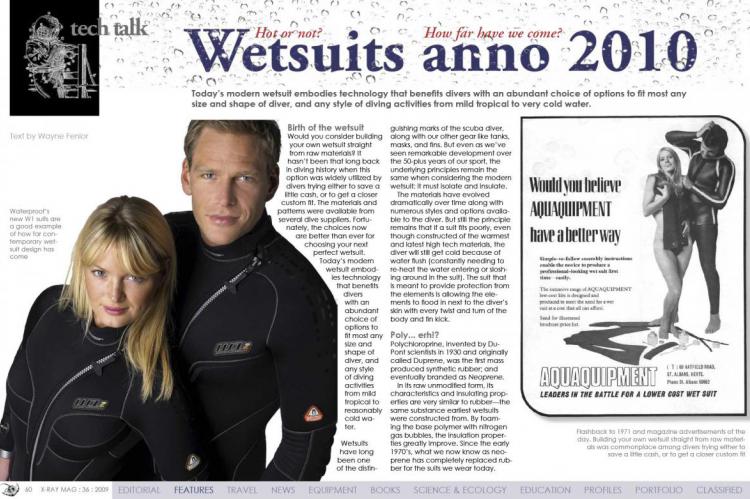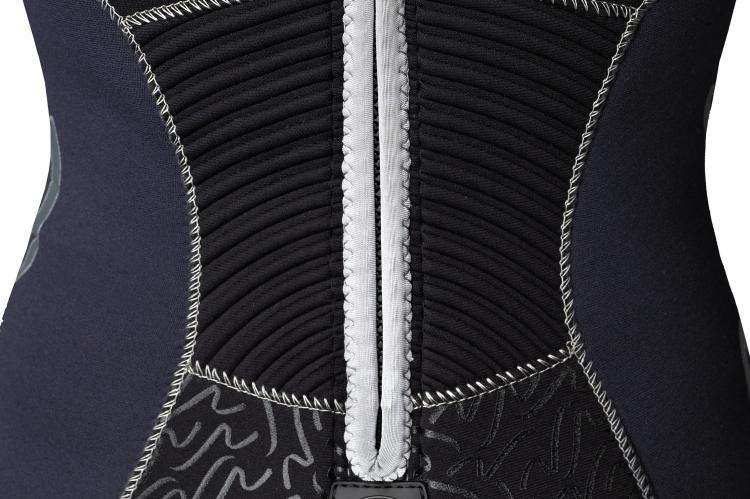Wetsuits anno 2010
Today’s modern wetsuit embodies technology that benefits divers with an abundant choice of options to fit most any size and shape of diver, and any style of diving activities from mild tropical to very cold water.
Tags & Taxonomy
Birth of the wetsuit
Would you consider building your own wetsuit straight from raw materials? It hasn’t been that long back in diving history when this option was widely utilized by divers trying either to save a little cash, or to get a closer custom fit. The materials and patterns were available from several dive suppliers. Fortunately, the choices now are better than ever for choosing your next perfect wetsuit. Today’s modern wetsuit embodies technology that benefits divers with an abundant choice of options to fit most any size and shape of diver, and any style of diving activities from mild tropical to reasonably cold water.
Wetsuits have long been one of the distinguishing marks of the scuba diver, along with our other gear like tanks, masks, and fins. But even as we’ve seen remarkable development over the 50-plus years of our sport, the underlying principles remain the same when considering the modern wetsuit: it must isolate and insulate.
The materials have evolved dramatically over time along with numerous styles and options available to the diver. But still the principle remains that if a suit fits poorly, even though constructed of the warmest and latest high tech materials, the diver will still get cold because of water flush (constantly needing to re-heat the water entering or sloshing around in the suit). The suit that is meant to provide protection from the elements is allowing the elements to flood in next to the diver’s skin with every twist and turn of the body and fin kick.
Poly... erh!?
Polychloroprine, invented by DuPont scientists in 1930 and originally called Duprene, was the first mass produced synthetic rubber; and eventually branded as Neoprene.
In its raw unmodified form, its characteristics and insulating properties are very similar to rubber—the same substance earliest wetsuits were constructed from. By foaming the base polymer with nitrogen gas bubbles, the insulation properties greatly improve. Since the early 1970’s, what we now know as neoprene has completely replaced rubber for the suits we wear today.
Full stretch
New materials in the last few years have given the diver the benefit of “full stretch” neoprene suits, which have spandex added to the material that is able to more closely fit the diver’s body. But a possible liability of these new “super stretch suits” is the temptation for the manufacturer to utilize the materials as a quick fix for poor design.
Remember also that as a suit needs to stretch to fit over problem fit areas, the insulation properties become less effective, as the suit becomes thinner. Another potentially dangerous problem that can occur as a diver squishes him- or herself into a suit that is just a bit tight is increased resistance effort in breathing underwater, as the wetsuit constricts the diver’s potential lung volume (remember your first instructor taught you to breathe slightly slower and deeper underwater from a regulator).
The lightweights
At the lightest end, one and two millimeter suits are available for the warmest tropical waters, and shorties (short sleeves and shorts), for the most tepid conditions.
These lightweight suits are effective above 27°C (80°F). Whenever diving in the ocean, I always recommend my students wear full suits for their protection benefits from scrapes and things that may sting if they get careless.
If you will be in the water for extended periods, or if your activity level is going to be low, opt for the heavier suit. Where and when thermoclines are possible, opt for the heavier suit! Even in my native sunny Florida on the same dive site the same day, a dramatic difference from morning to afternoon can be seen because of a thermocline that moved over the area. For safety sake, the diver should opt for more insulation, as you can always vent or flush the suit.
Mediums
Medium weight wetsuits are generally constructed with five millimeters of neoprene. Options for your style of diving include two-piece suits with farmer John/Jane bottoms and jacket style uppers that combine to give you two layers of insulation on your torso, in addition to the now traditional one piece suits.
The 7mm
For cold water below 21°C (70°F), 7mm neoprene will be necessary for all but the most active divers. It is in this category of suits where the manufacturers have the most opportunity for innovation. In addition to one-piece suits, be sure to ....
(...)
Download the full article ⬇︎

Originally published
X-Ray Mag #36
Dive into Sweden: rugged coasts, drop-off's, clear lakes and centuries old wrecks
| Wetsuits anno 2010 - all you need to know | Find out why off-shore wind turbines are also good for marine life; Marine scientists have discovered ocean “superhighway” for tiny life forms; A massive Southern Ocean current has been discovered; NOAA responds to Gulf oil spill; Chemicals from seaweeds damage corals on contact; Learn about Eukaryotic phytoplankton; Ocean bacteria can harvest sun energy; Get the Annapolis update; Rob Rondeau's marine archeology 101; Carol Tedesco's 17th century shipwreck treasures of green stone; Underwater cinematographer Mike Valentine; Spiny Dogfish as per A



